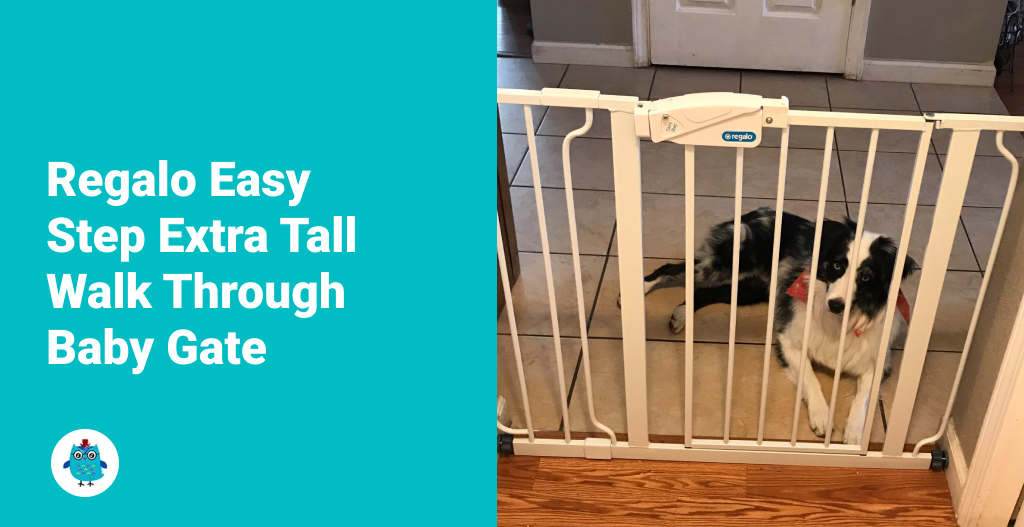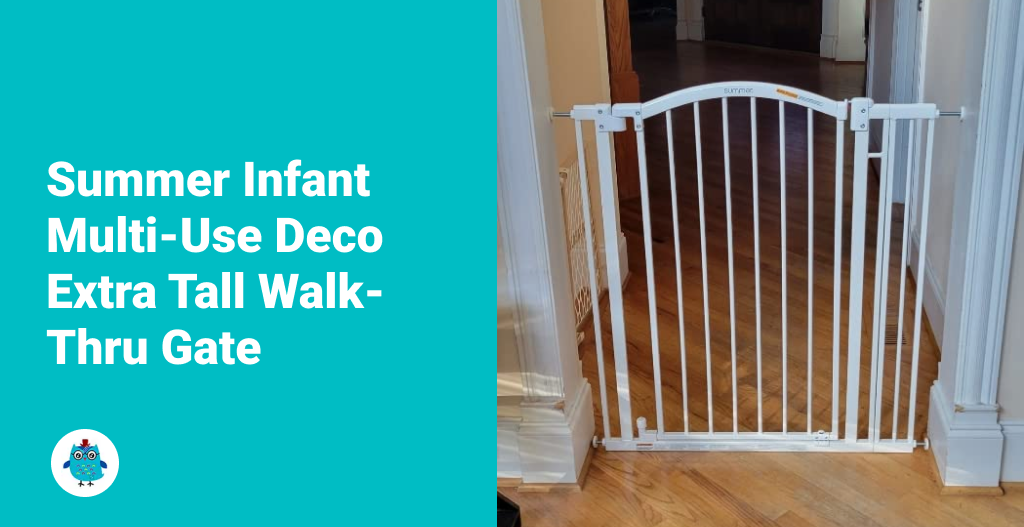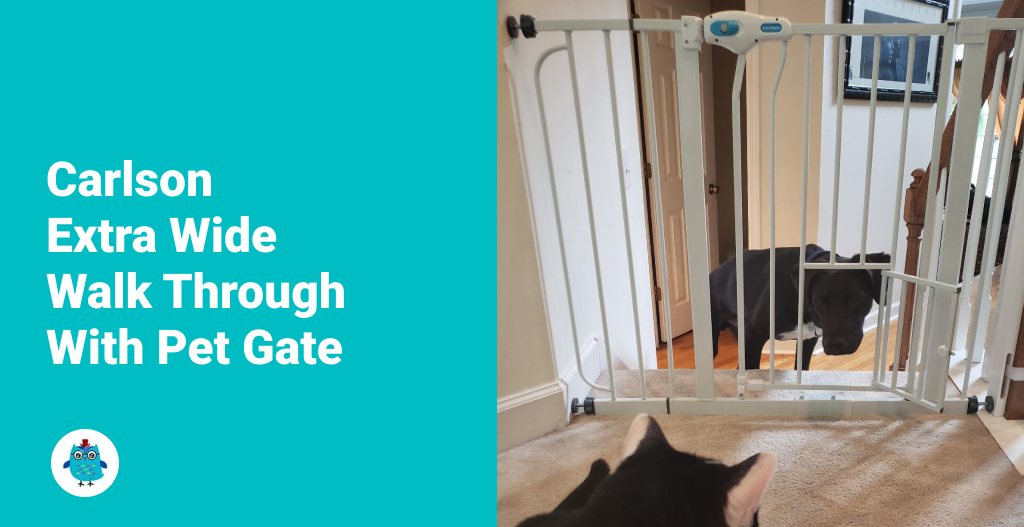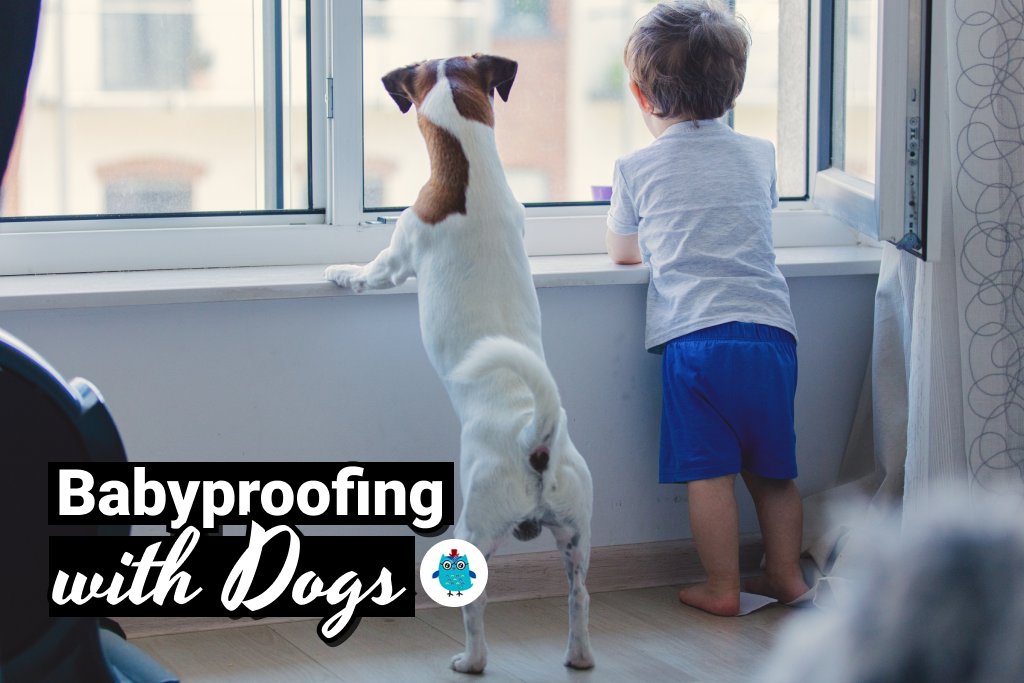Discover the differences between baby gates and dog gates. Choose the perfect gate to keep your kids and puppies safe.
Baby gates and dog gates are not the same, though they may share some similarities. Baby gates are specifically designed with a child’s safety in mind, meeting higher safety standards. In contrast, dog gates are tailored to contain or restrict pets’ movement. Choosing the appropriate gate for each purpose is essential to ensure children’s and pets’ safety.
As a dad of two, I know the struggle of finding the perfect baby gate. That task becomes even more daunting when you have a furry family member. The good news is I’m here to help you get more clarity about baby gates vs. dog gates. This guide will help you find the best baby gate to protect your kids and pets. So you can have peace of mind and focus on enjoying those precious moments with your little ones.
This article will cover the following:
- Key Features
- Brands
- Height
- Materials
- Lock Mechanism
- Standards
- Design
- Mounting type
- Purpose
- Best gate for dogs and children
- Conclusion
So, let’s dive in and explore what you should look for when you have a dog at home.
Baby vs. Dog Gates: Are Baby Gates and Dog Gates the Same
You might wonder if you could use a baby gate for your dog or vice versa. One obvious thing is that baby and dog gates have some notable similarities. I have some insights to help you determine if one type of gate can meet your child’s and pet’s needs.
Let’s break down the key features of each.
Key Features of Baby Gates and Dog Gates
- Safety Locks: Baby gates have childproof locks to prevent curious little hands from opening them. While not always childproof, dog gates often have a locking system that’s easy for adults to operate but secure enough to keep dogs in place.
- Height: Baby gates are usually around 30 inches tall, making climbing difficult for young children. Dog gates are often taller than baby gates to accommodate larger breeds, typically between 30 to 42 inches.
- Sturdy Material: Baby gates are made from materials like metal, wood, or durable plastic to withstand the wear and tear of active kids. Dog gates are also made of materials that can withstand a dog’s size and strength.
- Certification: When choosing a gate for your child, look for gates that meet safety standards, like the Juvenile Products Manufacturers Association (JPMA) certification. Baby gates are designed with child safety in mind, while dog gates cater to the needs of our furry friends.
Navigating the world of baby and dog gates can be overwhelming, especially with so many brands to choose from. I’ve compiled a list of the most trustworthy brands.
Brands That Make Both Baby Gates and Dog Gates
Some brands cater to both baby gates and dog gates. Let’s explore these dual-purpose brands and see how they can make your life easier.
- Regalo: Regalo is a versatile brand offering gates for babies and pets. Their gates are known for being sturdy and easy to install, perfect for keeping your little ones safe and your pets contained. My cousin Laura loves her Regalo gate
 , which has a walk-through door and easy one-handed operation.
, which has a walk-through door and easy one-handed operation. - Carlson Pet Products: Carlson creates gates suitable for children and pets. Some models feature a built-in pet door for smaller animals. My neighbor Stephanie has a Carlson gate
 , and she loves how it keeps her dog contained while allowing her cat to pass through.
, and she loves how it keeps her dog contained while allowing her cat to pass through. - Summer Infant: While primarily focused on baby products, Summer Infant’s gates can also work as dog gates. Their stylish designs and reliable safety features make them an excellent choice for families with both babies and pets. My coworker uses a Summer Infant gate as a dual-purpose
 solution for his baby and dog. He loves that it’s safe for his child and strong enough to contain his energetic pup.
solution for his baby and dog. He loves that it’s safe for his child and strong enough to contain his energetic pup.
When looking for a gate that can work for your baby and dog, it’s reassuring to know that some brands cater to both needs. By considering these dual-purpose brands, you’ll save time and effort while ensuring the safety of your entire family.
Height: Gate Size for Kids and Pets
When it comes to baby gates and dog gates, one of the main differences is their height. Let’s discuss the height variations between these gates and how it affects our decision-making.
- Baby gates usually range between 28-32 inches tall. These heights are designed to prevent your toddler from climbing over the gate and keep them safe in designated areas.
- Dog gates come in various heights, depending on the size and breed of your dog. They range from 20 inches for smaller dogs to over 40 inches for larger breeds.
Consider your dog’s size and jumping ability if you’re using a gate for your baby and dog. Choose a gate that’s tall enough to keep both your child and pet safe.
Some gates are designed to be extra tall, providing a versatile option for families with babies and dogs. These gates can be 36 inches or taller, ensuring the safety of everyone in the household. My neighbor has a tall gate that works wonders for her toddler and a large dog. The gate keeps her child and pet secure, giving her peace of mind.
When choosing a gate for your home, it’s crucial to consider the height differences between your baby and dog. Also, depending on your dog’s strength and personality, you want to consider the type of material.
Materials: Built to Last Gates
Here are the different materials available for both gates and how they can impact your decision-making.
- Wooden Gates: Wooden gates offer a classic look and are strong enough to withstand your baby’s attempts to push or climb. However wooden dog gates look great but might not be the best choice if your dog is a notorious chewer. My buddy has a wooden dog gate that was damaged by his dog’s chewing habits.
- Metal Gates: Metal gates are durable and can be more resistant to chewing if you have a dog that likes to nibble. My sister has a metal gate that her teething baby and dog can’t damage.
- Plastic Gates: Plastic gates are lightweight, easy to clean, and affordable. However, they might not be as sturdy as wooden or metal options.
- Mesh Gates: Mesh gates are lightweight and portable but may not be as sturdy as metal or wooden. A friend uses a mesh gate when traveling with her dog but prefers a more robust gate at home.
Consider your dog’s chewing habits and energy level when choosing the right material. A metal gate might be better if your dog is an aggressive chewer.
I also recommend you balance durability with aesthetics when choosing a gate material. Wooden gates look great but may not hold up like metal ones. Plastic or mesh gates can be affordable if you’re on a tight budget. However, remember that you may need to replace them more frequently.
Next, let’s unlock the secrets of lock mechanisms.
Locking Systems: Safety First
The locking system is crucial when choosing between baby and dog gates. I’ll break down different lock systems and explain which offers the best security for your little ones and furry friends.
- Baby gate locks are designed to be childproof, meaning they require a bit more skill or strength to open. Most baby gates use a dual-locking system. They add an extra layer of security by requiring two separate actions to open.
- Dog gate locks, on the other hand, prioritize ease of use for adults while still keeping your pup contained. These locks can be foot-activated or even a simple sliding latch. These locks make it easy for adults to pass through but keep pets contained.
If the gate is needed for a child, you should opt for a baby gate with a childproof lock. Especially if the gate is installed to prevent your child from accessing dangerous areas of your home.
Therefore, consider the level of safety needed for your family. Dual-locking systems provide extra security for baby gates, while latch or foot-activated locks work well for dogs only.
Besides the lock mechanism, the quality standards differ from one type of gate to another.
Standards: Raising the Bar
Regarding baby and dog gates, it’s crucial to understand the different standards to ensure your little ones are secure. If you’re looking for a baby gate, consider the following:
- JPMA Certification: Baby gates with Juvenile Products Manufacturers Association (JPMA) certification meet strict safety standards.
- ASTM Standards: The American Society for Testing and Materials (ASTM) sets voluntary standards for baby gates.
On the other hand, Dog gates don’t have a specific certification like baby gates, but that doesn’t mean they aren’t safe for your pup. Dog owners focus on durability and sturdiness when choosing a gate.
While baby and dog gates have different standards, choosing the right one involves prioritizing safety and durability.
Design Features for Safety
When it comes to baby gates, safety is paramount. Here are the important design features of baby gates and dog gates.
- Slat Spacing: Baby gates typically have narrower slat spacing (around 2-3 inches) to prevent little hands or heads from getting trapped. Dog gates often have wider slat spacing (around 3-4 inches) to accommodate larger breeds while preventing them from squeezing through.
- Rounded Corners: Many baby gates have rounded corners and smooth edges to avoid injuries. My son bumped one too many times into our gate but always walked away unscathed!
- No Foot Holds: Baby gates are designed without horizontal bars or footholds that curious climbers could use to scale the gate.
- Sturdy Construction: Dog gates are designed to withstand the force of a large or active dog. My neighbor’s gate held up to her energetic Labrador Retriever!
- Tall Height: Some dog gates are extra tall to prevent jumping or climbing dogs from escaping. My friend’s Greyhound couldn’t clear his extra-tall dog gate.
Focus on design features like slat spacing, rounded corners, and sturdy construction to ensure your little ones (furry or not) stay safe.
Now, let’s tackle mounting types.
Mounting Types for Maximum Security
I know that installing a gate can be a challenge. Let’s compare the mounting types to ensure your child and furry friend stay safe and secure.
- Pressure-Mounted Gates: They are super convenient since they don’t require any drilling. Pressure-mounted dog gates work well for smaller, less energetic dogs. Remember that there are better choices than pressure-mounted gates for top-of-stairs or larger dogs, as they can be pushed over with enough force.
- Hardware-Mounted Gates are screwed into the wall for a strong, secure fit. When my little climber tried to scale his hardware-mounted gate, it didn’t budge an inch! Hardware-mounted dog gates provide the sturdiness needed to keep larger or more energetic dogs contained. Although more difficult to install, hardware-mounted gates offer extra security. They are ideal for the top of stairs or when containing larger dogs.
- Freestanding Gates: They are less common but useful for temporary or travel situations. Freestanding dog gates are perfect for creating a temporary barrier or play area for your dog. While they offer flexibility, they may provide a different level of security than pressure-mounted or hardware-mounted gates.
The bottom line is, Consider pressure-mounted gates for quick installation, hardware-mounted gates for maximum security, or freestanding gates for portability. Also, the location where you install the gate might influence the type you select.
Gate Purpose: Where the Gate is Install
It’s essential to consider the location and purpose when choosing between baby and dog gates. By understanding the unique needs of each area in your home, you’ll create a safe and secure environment for your kids and pets.
- Staircase: Installing a gate at the top or bottom of stairs can prevent falls and limit access for kids and pets. The hardware-mounted gate is the only safe option for stairs.
- Kitchen: Keep kids and pets away from hot surfaces and sharp objects. I installed a baby gate in our kitchen doorway to keep my kids from wandering in while I was cooking. Dog owners could use a dog gate to keep their curious pup from eating the food on counters or getting underfoot.
- Outdoor: Create a safe play area for kids and pets on your patio or deck. For this situation, a freestanding gate can do the job. However, they are not secure enough for the pool area.
- Bedroom: Keep babies and toddlers in their room during bedtime or naptime. Our buddy Mike used a dog gate to keep his dog from disturbing his baby’s sleep. In this case, any gate would work.
Now the big question. Which gate should you get?
Choosing the Right Gate for Your Family When You Have a Dog
Feeling overwhelmed by all the options? I understand the struggle to find the right gate to keep everyone safe and happy. When choosing a baby gate that can also handle your furry friend, consider these factors:
- Strength and Durability: You want a gate accommodating curious toddlers and energetic dogs. Look for sturdy materials like metal or heavy-duty plastic.
- Height: A taller gate is essential if you have a dog who loves to jump. Most baby gates are around 30-32 inches tall, but you should go higher if your pup has a history of acrobatic stunts.
- Latch System: A secure, childproof latch is necessary for baby gates. But remember your dog’s clever paws! Make sure the latch is also challenging enough for your furry escape artist.
- Location and Installation: Consider where you’ll place the gate and whether you need hardware-mounted or pressure-mounted options. Hardware-mounted gates are more secure but require drilling into walls. Pressure-mounted gates are easier to move and install but might not be suitable for top-of-stair use.
- Ease of Use: As busy parents, we need a gate that’s easy to open and close, preferably with one hand (while holding a baby or a cup of coffee in the other!). Look for gates with convenient walk-through doors and simple locking mechanisms.
Remember, the key is finding a gate that keeps everyone safe without making your life more complicated.
Top Baby Gates That Keep Both Kids and Dogs Safe
After talking to other parents and dog owners, I’ve compiled a list of popular baby gates that work well for kids and dogs. Here are some parent-approved options:

Regalo Easy Step Extra Tall Walk Thru Gate
The Regalo Easy Step Extra Tall Walk Thru Baby Gate is a versatile, pressure-mounted gate designed for safety and convenience. With its 41-inch height and expandable width (29-34 inches, with a 6-inch extension included), this gate is perfect for parents looking to keep their toddlers and pets contained. The one-hand open safety latch provides easy access for adults, while the all-steel construction ensures durability and security in your home.
For more information, such as price, check out the Regalo Walk Thru Gate on Amazon here.

Summer Infant Multi-Use Deco Extra Tall Walk-Thru Gate
The Summer Infant Extra Tall Walk-Thru Safety Gate is a sturdy, pressure-mounted gate designed to keep your child safe and secure within your home. Standing at 38 inches tall, it’s perfect for taller children and large pets, with an adjustable width of 29-47 inches for a snug fit in various doorways and openings. The gate features an auto-close door and a simple, one-handed walk-through design, making it convenient for adults while maintaining the highest level of safety for your little ones.
For more information, such as price, check out the Summer Infant Extra Tall Gate on Amazon here.

Carlson Extra Wide Walk-Through Pet Gate
The Carlson Extra Wide Walk Through Pet Gate is a versatile, pressure-mounted gate designed to keep your pets contained while providing easy access for adults. With its 30-inch height and expandable width (29-36.5 inches), this gate features a built-in small pet door (10×7 inches) that allows smaller pets to pass through while keeping larger pets secure. The all-steel construction ensures durability and security, while the easy-to-use lever-style handle with a one-touch release safety lock offers convenience for adults.
For more information, such as price, check out the Carlson Extra Wide Walk-Through Pet Gate on Amazon here.
Every family’s needs differ, so choose the gate that best fits your home and lifestyle. Once you’ve made your choice, you’ll feel relieved knowing that your little ones and a furry friend are safe and sound.
Conclusion
As parents and pet owners, you might wonder if you can use a baby gate as a dog gate or vice versa. Generally, it’s safer to use a baby gate as a dog gate rather than the other way around. Since baby gates are designed with higher safety standards, they can effectively contain your child and your dog.
While baby gates can be pricier than dog gates, it’s crucial to prioritize safety over savings. Investing in a quality gate will give you peace of mind knowing your child and dog are safe and sound.
With the right gate, you can finally sit back and watch your family (furry members included) grow and thrive together.
Happy baby-and-dog-proofing!

